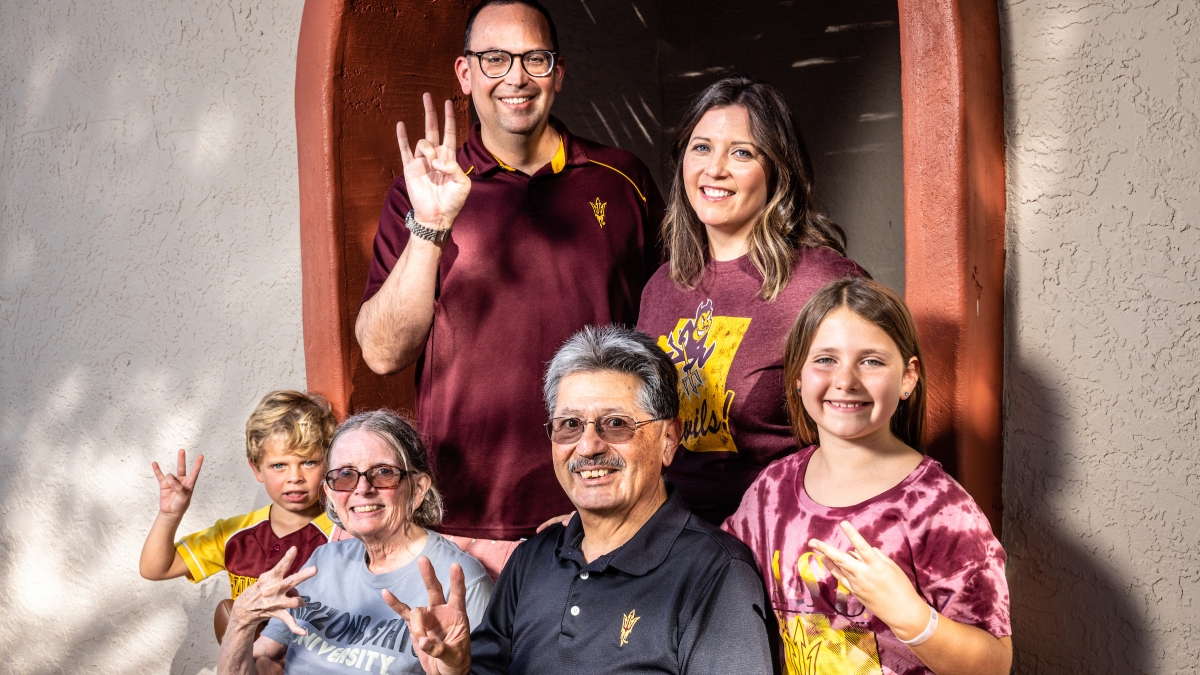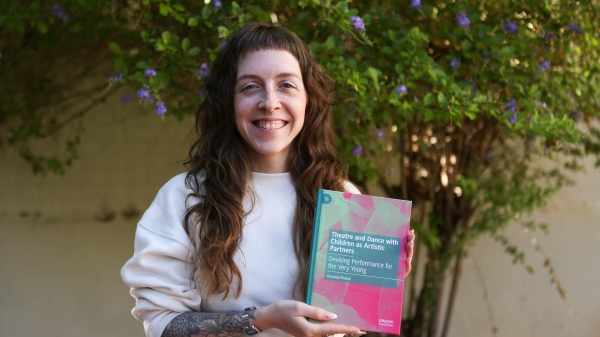Sun Devil generations

Three generations of the Alvarado-Parsons family pose for a portrait: (clockwise from top) siblings Emiliano Alvarado and Adriana Alvarado-Parsons; Anisa Parsons, 9; husband and wife Joe Alvarado and Paulette Welch; and Mateo Parsons, 6, on Sept. 25 at home in north Phoenix. Grandparents Paulette Welch and Joe Alvarado completed their bachelor's (1971 and 1976, respectively) and master's (1976 and '81) degrees in education at ASU. Mother Adriana Alvarado-Parsons earned her ASU journalism degree in 2005; and uncle Emiliano Alvarado received his ASU digital marketing certificate in 2021. Photo by Charlie Leight/ASU News
Mateo Parsons, 6, makes a pitchfork with his little hand whenever he sees Sparky, and his blue eyes gleam when he draws near his grandfather, Joe Alvarado, whom he calls “Tata.”
Little Mateo’s college plans are set: He’s expected to attend Arizona State University like his mom, his uncle and his Tata before him.
But his experience will be different from that of his family members, who faced challenges that ranged from trying to get to college and financial barriers to being accepted by peers and seeking guidance on campus. A lot has changed since Tata became a Sun Devil in the early ’70s.
This year, a record number of Latino students are enrolled at ASU. More than 30,000 on-campus and ASU Online students identify as Hispanic or Latino. In June, the Department of Education named ASU a Hispanic-Serving Institution, which means at least 25% of enrolled undergraduates are Hispanic.
That wasn’t the case when baby boomer Joe Alvarado graduated with his undergraduate degree in 1976. Both of his children, Emiliano Alvarado, a Gen Xer, and Adriana Alvarado-Parsons, a millennial, attended ASU. Like their father before them, their paths to college were not traditional or easy.
The first in the family
In the late 1960s, a copper mining strike got in the way of Joe Alvarado’s quest to go to college.
Disgruntled miners in Globe, Arizona, where 72-year-old Joe Alvarado is from, shut down operations in 1968. He had no money to attend a university, so he went to community college instead, eventually transferring to ASU. The Chicano movement made him an outspoken voice on campus, but he said he struggled to find support or guidance at the university.
“I got very little assistance,” said the retired school principal, who earned his Bachelor of Arts in elementary education in 1976 and his Master of Arts in education administration in 1981 at ASU. “I didn’t even know I had a counselor at ASU. Honestly, it was a little intimidating.”
It’s a common struggle for many Latino students, to get on the pathway to college and stay on.
“His story is a perfect example of why educational outreach was created,” said Vanessa Ruiz, deputy vice president for outreach within Educational Outreach and Student Services at ASU. “We’ve made tremendous gains so that there are no more stories like this.”
Ruiz leads efforts that aim to eliminate barriers to college at ASU. It takes the form of a range of programs, including WeGrad, a digital curriculum that is designed as a self-paced, self-discovery program that provides college-prep tools so that families can in essence “graduate together.” It connects families with resources and strategies to help students succeed in college and beyond.
“This will allow ASU to help even more underrepresented and underserved families help support their students on the successful road to college,” said Ruiz.
Another far-reaching offering is the Hispanic Mother-Daughter Program, which is an early-outreach middle and high school program that includes all family members in the college journey. With the goal of increasing the number of first-generation Arizona students who are qualified and prepared to enroll at ASU, the nearly 40-year-old program has helped thousands of students succeed and pursue their passions.
From a new century to a pandemic: The Alvarado children go to ASU
International correspondent and anchor Ann Curry’s heart, grit and passion inspired Alvarado-Parsons, 38, to study journalism. There was also another draw: Curry is biracial, just like her. Alvarado-Parsons wanted a diploma from ASU’s Walter Cronkite School of Journalism and Mass Communication but, as a high school student in Flagstaff, Arizona, she noticed ASU was absent during college recruiting events. Frustrated, her father stepped in.
“I just made a call,” said Joe Alvarado, who was an administrator in the Flagstaff Unified School District at the time; his call, in 2001, prompted recruiters to visit. “There were a lot of kids wanting to go to ASU, but I noticed the lack of access again.”
His daughter attended the Cronkite School’s summer camp and stayed in Manzanita Hall for a week, but she said it was overwhelming.
“You don’t realize the scale of ASU until you get there. The rural kids gravitated toward each other because we were not familiar with the city or the university,” said Alvarado-Parsons, who graduated in 2005 with a Bachelor of Arts in broadcast journalism from the Cronkite School.
There are efforts today to help ease that transition for students, including the fact that every Arizona high school now has an ASU admissions representative.
“Today we work closely with Arizona high schools and high school counselors to try and make students aware of not just the basic admissions criteria but the right tools and resources,” said Associate Vice President of Admissions Matt Lopez.
And it’s not just outreach to the K–12 market that has changed. The university is shifting to better serve learners throughout their lives.
“We’d like all individuals who want to learn for personal or professional growth to be able to build a lifelong relationship with the university and take advantage of our offerings,” said Maria Anguiano, executive vice president of Learning Enterprise, which leads ASU initiatives and programs that serve learners from pre-kindergarten to post-retirement stages in life.
Both Ruiz and Lopez acknowledge that technology is critical in reaching both lifelong learners and college-bound students, especially Hispanics — studies show Latinos have one of the most rapidly growing rates of internet usage among various demographics. And during the pandemic, online options gave many people the chance to pursue a college degree or non-degree-based educational offerings remotely.
Emiliano Alvarado, who already had a degree from NAU, decided to invest in his career during the pandemic and earned his online marketing certificate from ASU in 2021.
“The ASU program was tailored for working professionals, and they supported recipients with career placement following completion,” said the 45-year-old, who is an administrative assistant in the University of Arizona Race Track Industry Program.
“I wanted to attend a state school — not only was ASU a family legacy, but it also happened to have the program that best matched my next-level professional development.”
Generation Alpha and reaching future Hispanic Sun Devils
Mateo Parsons and his sister Anisa, 9, are part of Generation Alpha, a generation predicted to be the wealthiest, most educated and technically advanced. Everything from their clothing, dating sites and amenities will likely be easily accessible.
“Although Generation Alpha will have technological wearables, more connectivity and a growing social media presence, we have to meet them where they are, provide digital assets and get information out early through advanced technology and financial literacy,” said Lopez.
That’s welcome news for mom Alvarado-Parsons, who looks forward to the advances in reaching all Latino students, not just hers.
“As a parent, I’m going to expect that we don’t have to travel and go to a preview of a camp because we’ll enjoy it from our home; I can experience the process with them. It will empower my kids and their generation.”
More Arts, humanities and education

Exhibit to feature artwork inspired by oral histories from Arizona's oldest botanical garden
Though it is Arizona's largest botanical garden and has been an established touchstone of the community for more than 100 years, many students in Arizona State University Professor Ellen…

ASU center to host Spike Lee for Delivering Democracy 2025 program
The Center for the Study of Race and Democracy at Arizona State University will host Academy Award-winning filmmaker and cultural icon Spike Lee on March 1 for its annual Delivering Democracy…

ASU professor explores theater, dance for young children in new book
Arizona State University Assistant Professor Amanda Pintore believes in the artistic capacity of very young children. She's hoping to spread that awareness to others with the recent publication of…